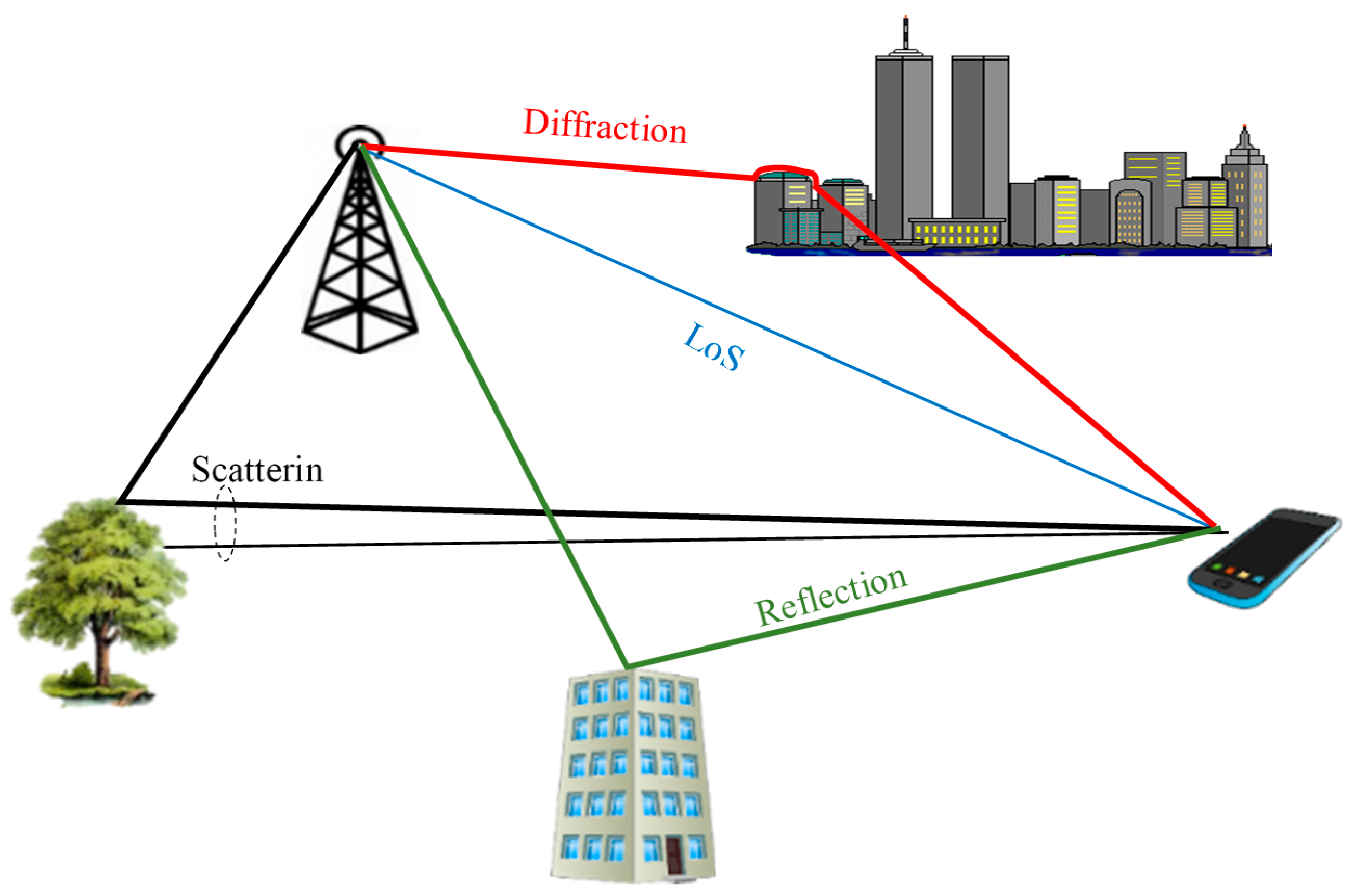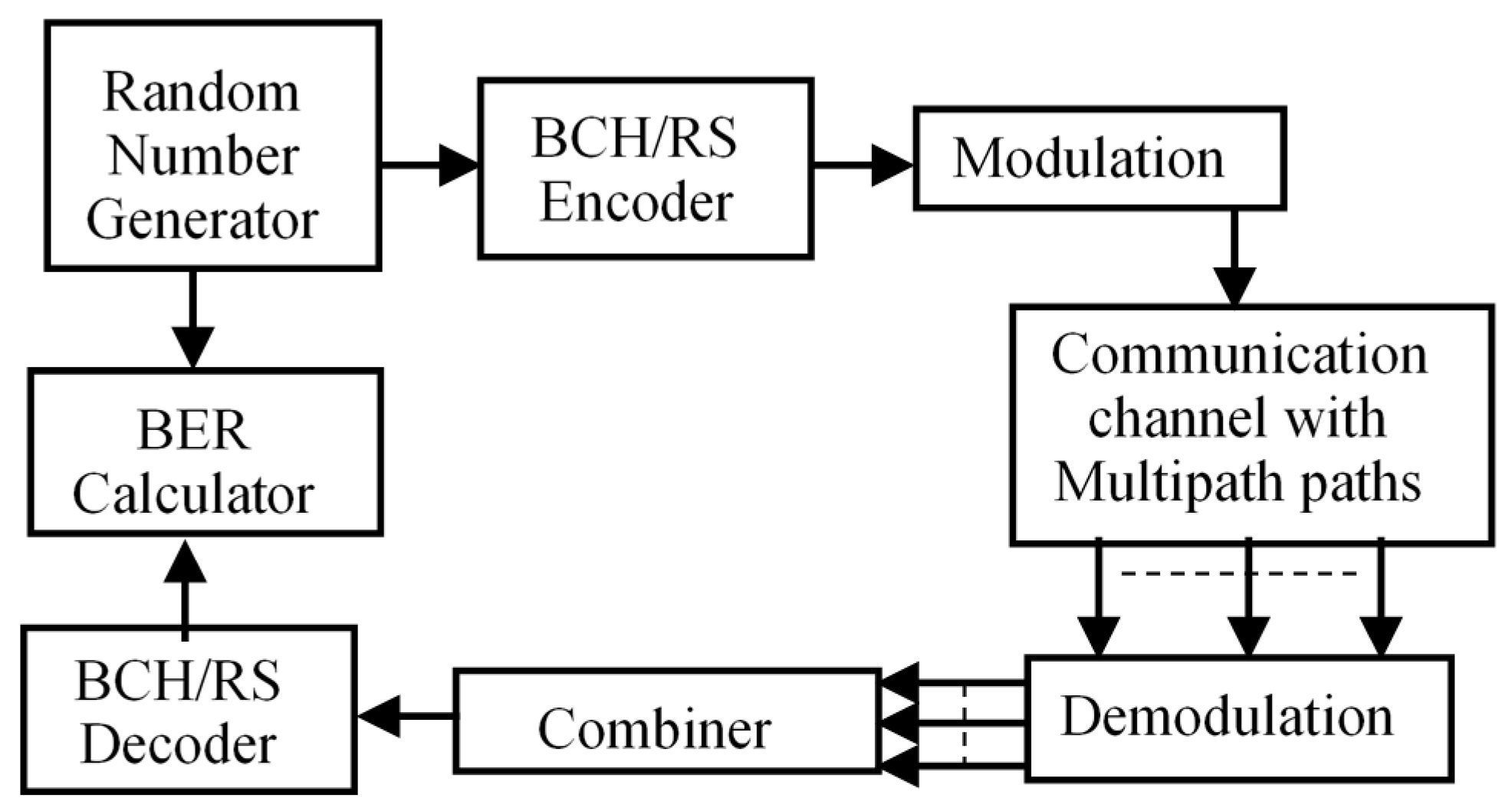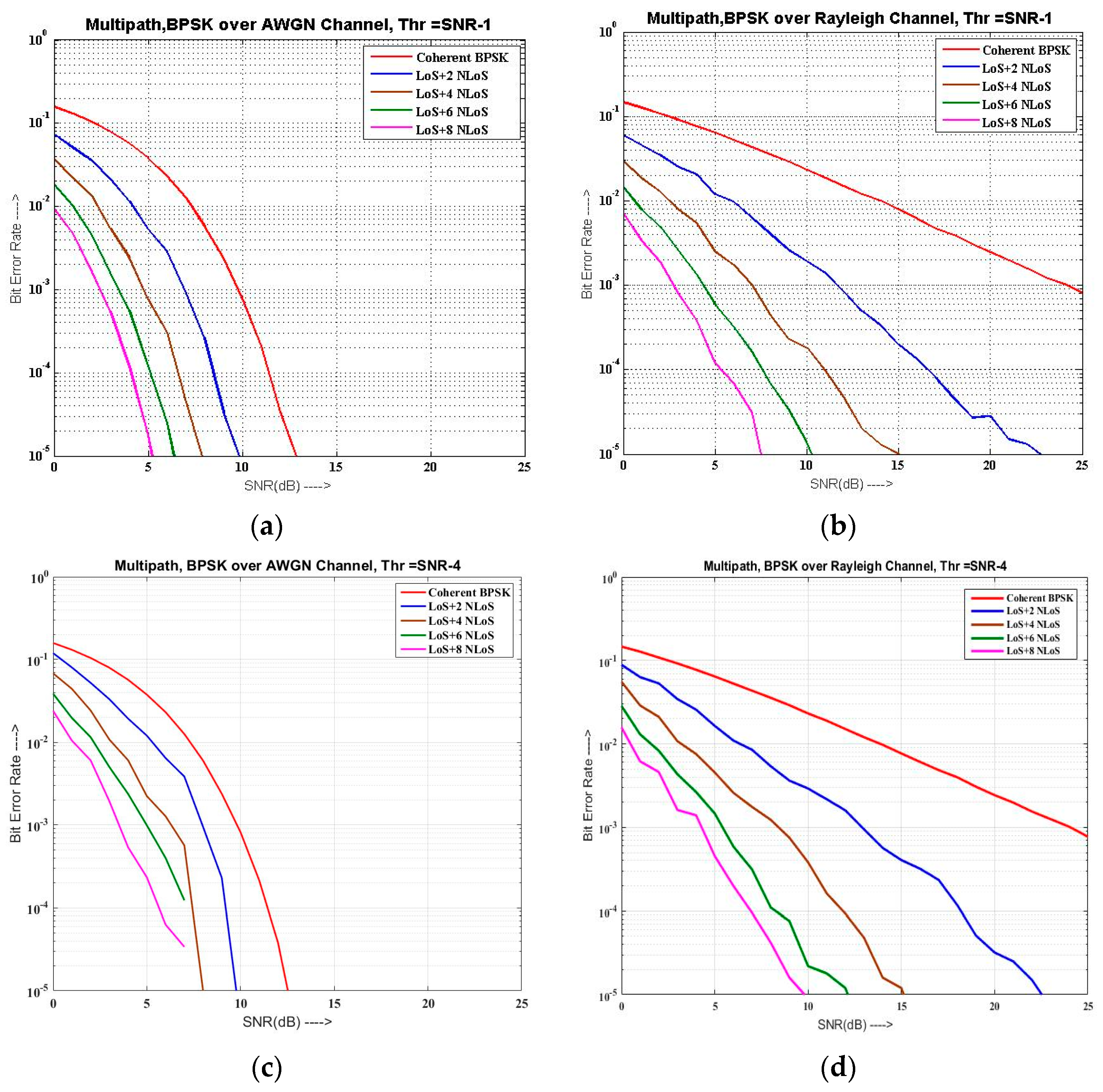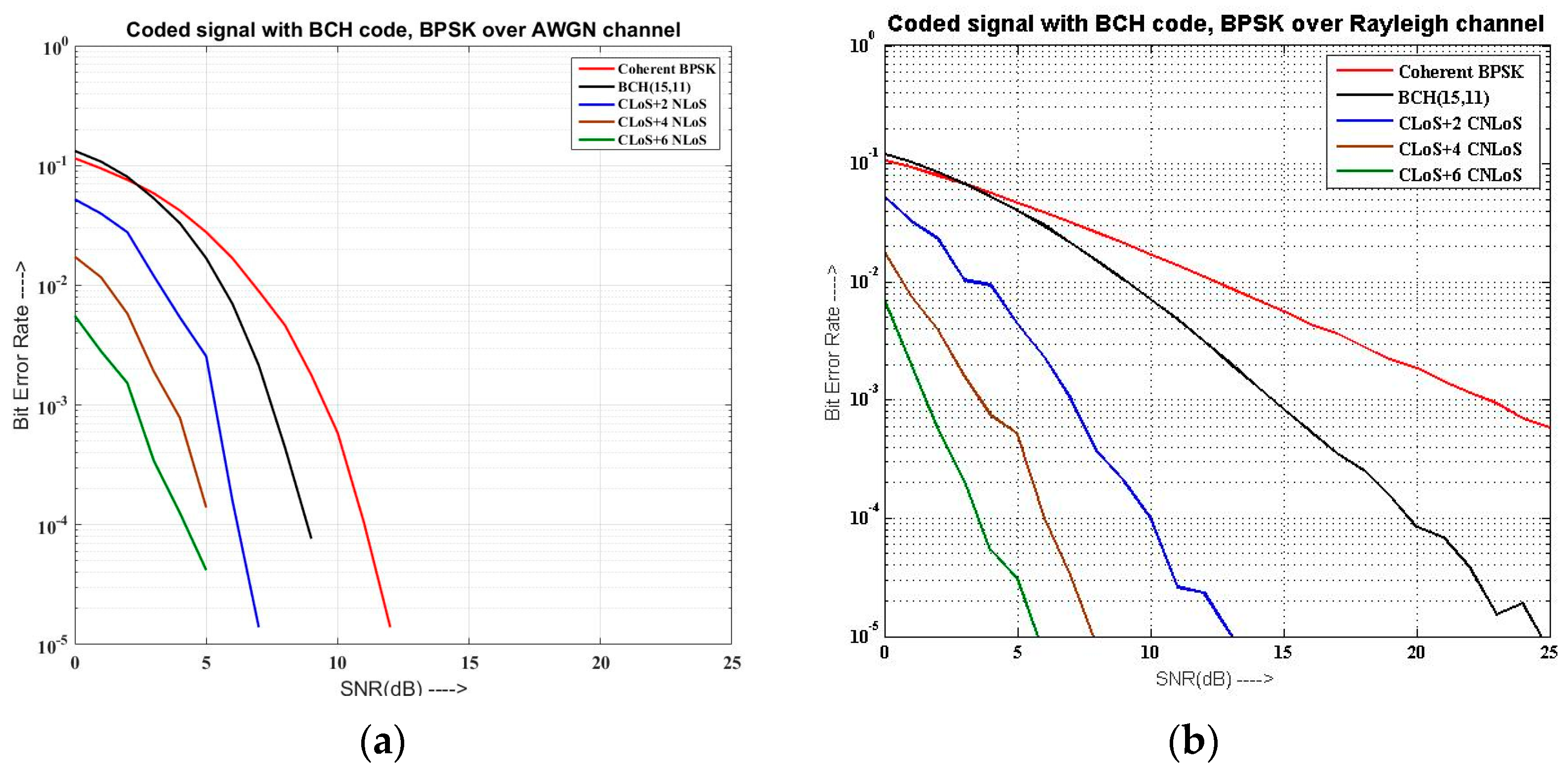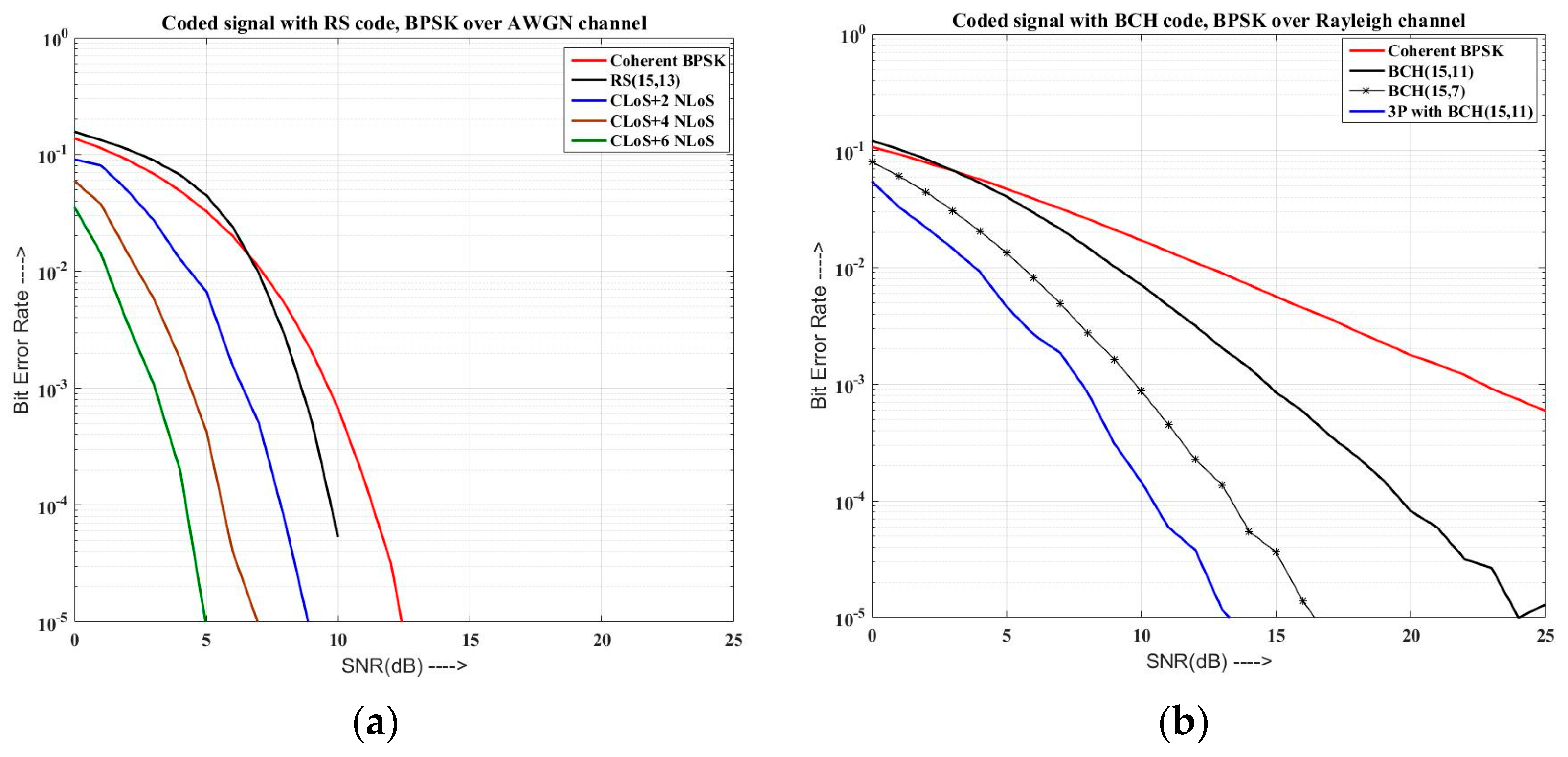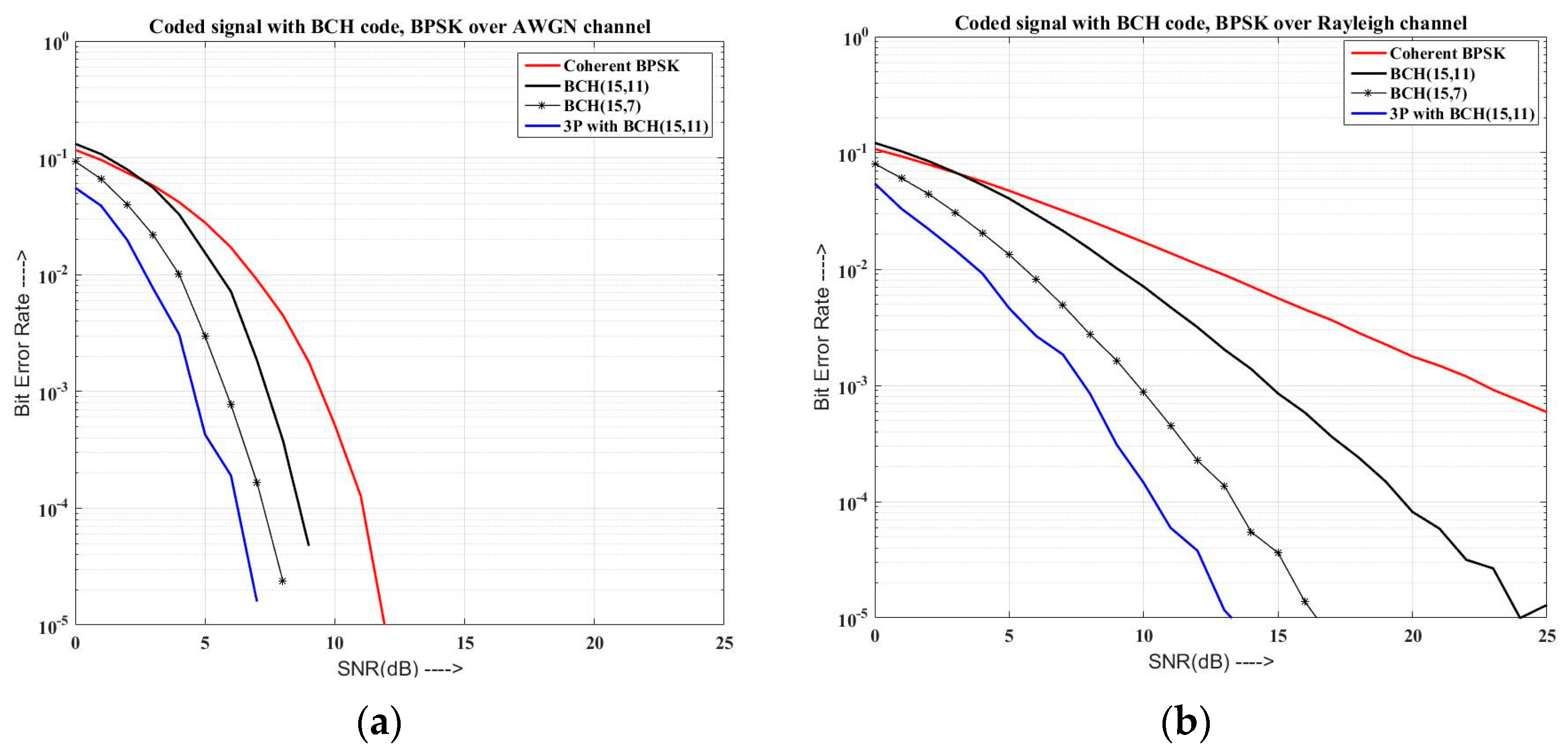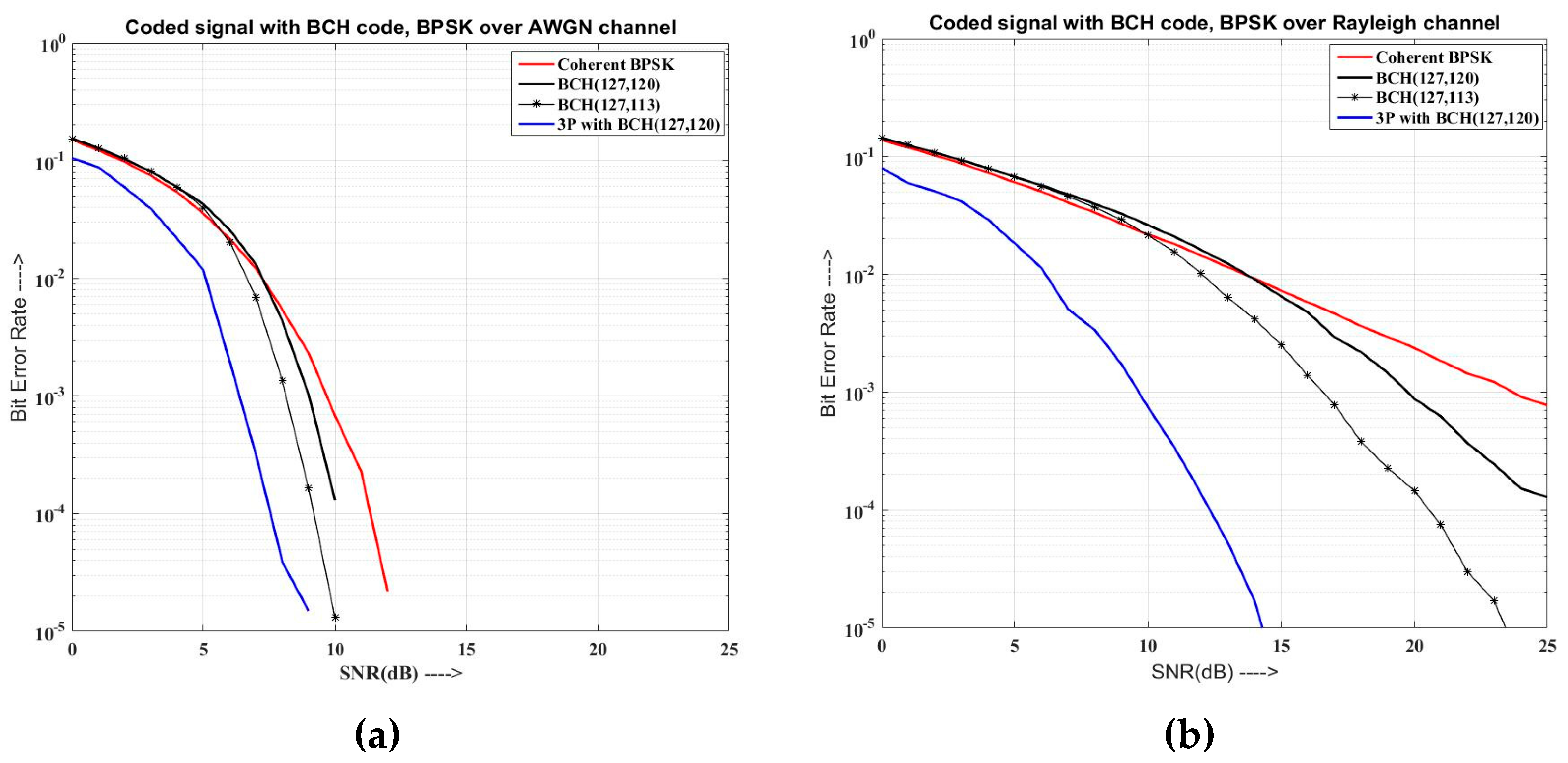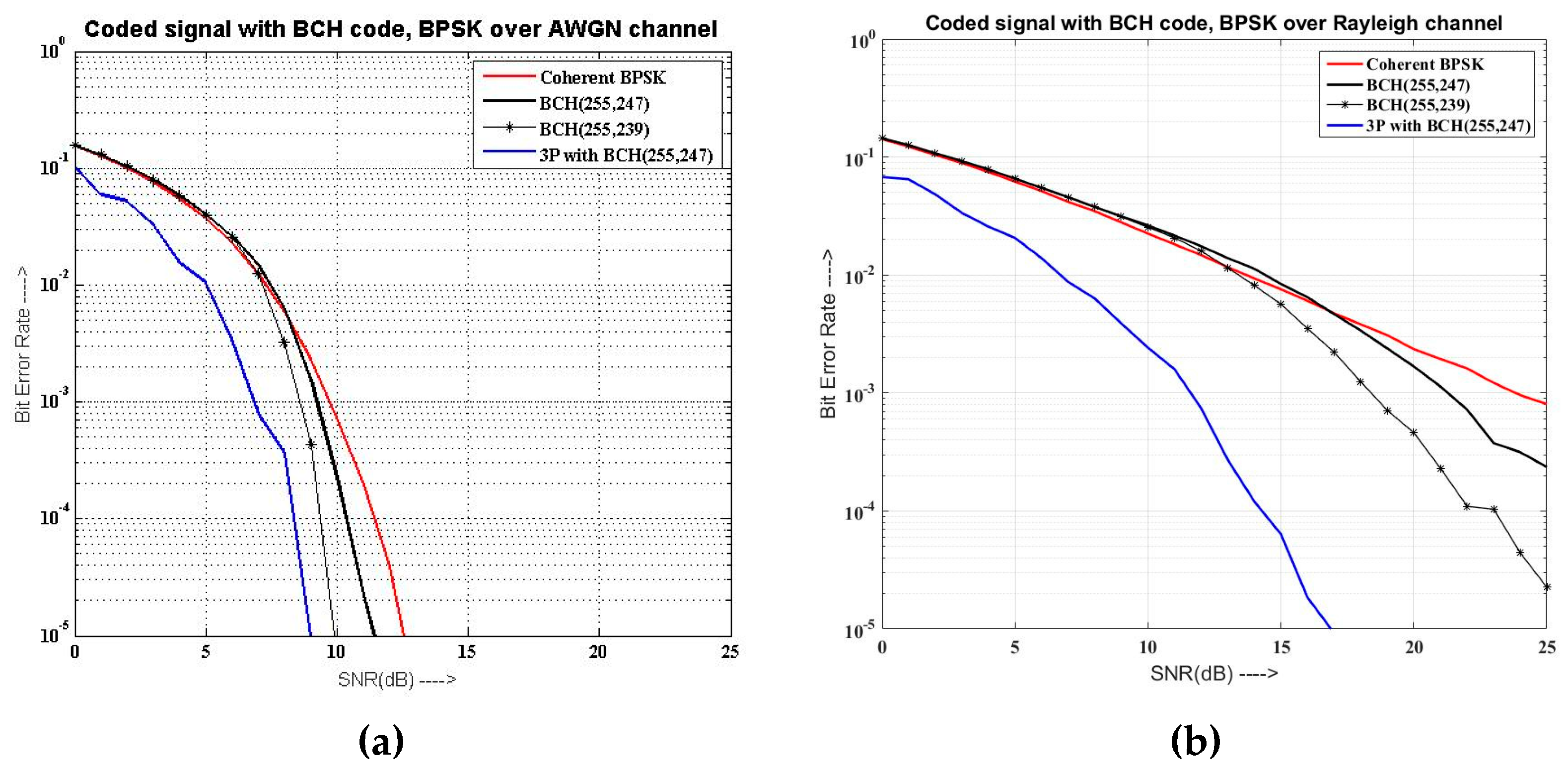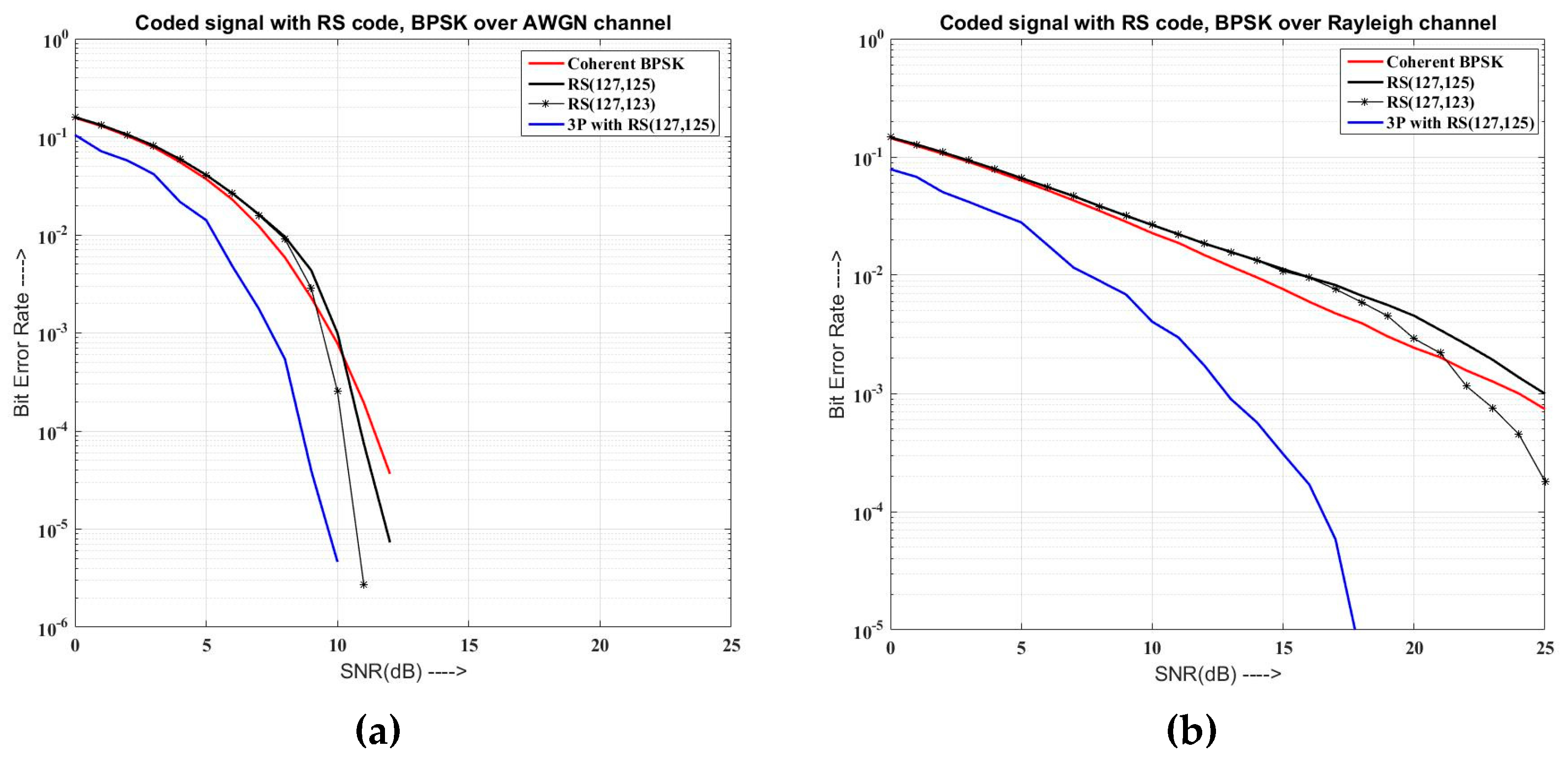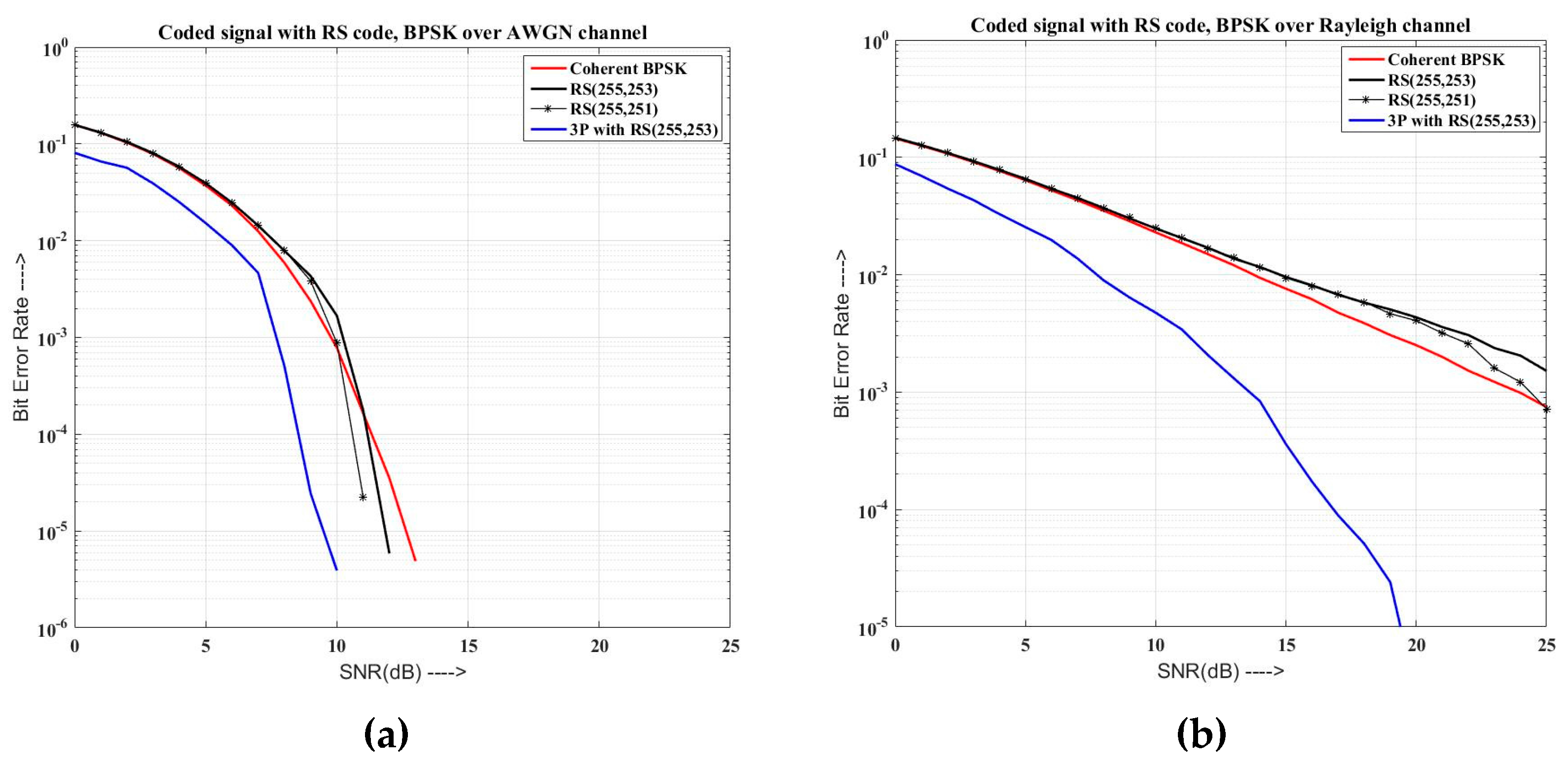1. Introduction
The past decade or so has witnessed remarkable growth in the demand for providing reliable communication links and high transmission rates. A reliable digital communication system involves the sending and receiving of data with vanishingly small error rates [
1,
2]. Any wireless communication system is prone to a certain level of noise, reflection, diffraction, shadowing, and fading. Furthermore, the signal that is transmitted through a wireless channel arrives at the receiver via a number of different paths, referred to as multipath transmission, and this leads to fading (signal distortion and burst errors) [
3]. Therefore, transmission reliability is very challenging on wireless channels. One of the most widely used techniques to provide reliable communication is forward error correction (FEC). The investment of FEC requires either increasing channel bandwidth or decreasing the rate of the transmission [
4]. Therefore, the high transmission rate and transmission reliability need high bandwidth, but the bandwidth is a substantial issue for communication which means that increasing the bandwidth is not a wise decision [
5]. In contrast, the multipath phenomenon can be utilised to improve communication reliability and increase the transmission rate without increasing bandwidth. In this paper, the effectiveness of the multipath phenomenon to improve the error correction capability (transmission reliability) with as little redundancy as possible is considered. In this article, Reed–Solomon (RS) and Bose, Ray–Chaudhuri, and Hocquenghem (BCH) codes with different parameters are used to provide high data rate transmission and analysis of the communication performance with and without multipath propagation.
The paper is organised as follows: Related work is given in
Section 2. A brief overview of FEC is demonstrated in
Section 3. The multipath phenomenon is described in
Section 4. The methodology is explained in
Section 5. In
Section 6 the proposed combiner is described. Simulation parameters, and results, are presented in
Section 7 with the conclusions being reported in
Section 8.
2. Related Work
Recently, research has shown intense interest towards analysing the performance of various FEC techniques rather than how to improve these without extra redundancy. Researchers have not taken into consideration the positive effect of the multipath phenomenon on the performance of FEC and how it could be utilised to improve FEC capability. Some authors have compared the performance regarding bit error rate (BER) of different forward error correction codes such as RS, convolutional code (CC), RS-CC, and CC-RS codes [
6]. They evaluated the BER of CC at various code rates. Likewise, they evaluated the performance of RS codes for different code rates, as well as block length. Furthermore, they compared the performance of both CC-RS and RS-CC concatenated codes with the individual codes and with uncoded data transmission. Some authors examined the performance of RS codes with binary phase-shift keying (BPSK) and quadrature phase-shift keying (QPSK) modulation over an additive white Gaussian noise (AWGN) channel [
7]. Additionally, they compared the performance of RS codes with the BCH codes. After examining the results, they found the RS code performance is better than the BCH code. Some authors implemented RS codes for phase-shift keying (PSK) modulation over the AWGN communication channel. They performed the simulation of RS codes for the same code rates. They showed that the BER performance is poor for lower signal-noise-ratios (SNRs). On the other hand, the BER performance improved for large block lengths [
8]. Moreover, other authors have simulated RS and BCH codes in the presence of a Rayleigh fading channel and have shown that the BCH code exceeds the RS code in the binary environment [
1].
This paper investigates the possibility of utilising the multipath phenomenon to improve the performance of FEC over the AWGN and Rayleigh channels. Additionally, analysis of the effectiveness of the utilisation of multipath propagation on the error correction capability of FEC with low redundancy was conducted. Furthermore, a combiner based on Hamming weight to combine the selected paths (redundant copies of the transmitted signal) into one strong signal to decode it is proposed.
4. Multipath Propagation
The multipath phenomenon is caused by atmospheric ducting, reflective surfaces (including water, buildings, and mountains), and ionospheric refraction [
4]. This phenomenon results in the receiver antenna receiving two or more copies of the same signal via different routes (see
Figure 2). The various path lengths cause each signal to have a different propagation delay. The first received signal is known as the line-of-sight (LoS), and the other signals are non-line-of-sight (NLoS).
Since all paths differ in their transmission length and propagation delay, the receiver could probably separate some of them and obtain two or more copies from the transmitted signal, considering the generalised assumption that the electromagnetic signals propagate through a vacuum at the speed of light, if the following condition is satisfied [
17,
18]:
TL represents the minimum transmission length. In this case, the delay time (
τ) needed to receive an uncorrelated path is:
For example, in the wideband code division multiple access (WCDMA) receiver, if the chip rate is 5 Mcps then
L will be at less than 60 m, and the chip duration or multipath delay
τ is equal to 0.2 µs, which will be enough to separate the multipath components to obtain more than one copy.
Table 1 shows different chip rates and the delay time required. In order to provide a wireless communication system with a high data transmission rate, these copies are employed to increase the error correction capability of RS and BCH codes without adding more redundant bits.
5. Methodology
Figure 3 shows the block diagram of a coded wireless communication system using BCH and RS codes with the existing multipath propagation.
On the transmitter side, binary sequences K-bits long are generated by a pseudo-random generator block and input into the BCH/RS encoder block. The encoder block maps k bits of the sequence into N bits of the sequence. The N bits are passed on to the BPSK modulator. The Gaussian-like (AWGN and Rayleigh) channel block is designed to introduce a fading effect and add noise to the modulated signal. The channel block helps to study and analyse the effect of the actual signal properties.
On the receiver side, L signals are chosen (LoS and (L − 1) from NLoS). The threshold which is used to choose L paths was selected randomly for each transmission. It represents the minimum signal-to-noise ratio (SNR) that can be accepted to consider the received signal as a copy of the original transmitted signal. If the received signal has a SNR less than the threshold, the receiver will ignore it. The threshold ranges between 40% and 75% from the SNR of the LoS signal. After selecting L signals (copies), the signals are first demodulated by the demodulation block to obtain the coded signals. After that, the demodulated signals pass to the combiner block to combine them into one good signal. The BCH/RS decoder block takes the result of the combiner block as an input and performs the appropriate decoding operation to recover the transmitted signal. The final step in the simulation is to compute the BER to analyse and study the performance of the coded communication system with and without the existing multipath propagation. The BER calculator block is designed for this purpose.
6. Column Weight Multipath Combiner (CWMC)
This paper proposes a combiner based on Hamming weight (
wh) to combine the LoS and NLoS signals. This combiner receives
L copies from one transmitted signal as the input (
L should be an odd number and include the LoS signal), then arranges them in an
L ×
N matrix:
where
,
, and
. represents the combiner output. For example, we assume five different codewords (
L = 5) which are ten bits long (
N = 10) each:
and:
The matrix will be like the below:
After calculating
,
Y will be:
Figure 4 shows that the combined packets improved the system BER performance, where the improvement is increased when the number of combined paths are increased. Additionally, the BER performance improvement depends on the threshold value (see
Figure 5). In
Figure 4 and
Figure 5, the red slope represents the uncoded signal (LoS), and the blue, brown, green, and magenta slopes represent the combining of the uncoded LoS with two, four, six, and eight uncoded NLoS signals, respectively.
7. Results
In this paper, analysis of BCH and RS codes over AWGN and Rayleigh channels has been conducted. The block length of (n1, k11) and (n1, k12) for the BCH code where k11 > k12, and (n2, k21) and for RS code where k21 > k22 and (n2, k22) are simulated with three, five, and seven paths. The threshold value was set at 40–75% from the SNR of the LoS signal to choose the NLoS signals. The BER ratio was computed by changing Eb/N0 from 1 to 25. In the simulation results, the red slope represents the uncoded signal (LoS). The black and the black with stars slopes represent the LoS which is encoded by using codes where t = 1, and t = 2, respectively. The blue slope represents the combining of the coded LoS with two coded NLoS, where LoS and NLoS are encoded by using codes where t = 1.
Figure 6 and
Figure 7 show that the BCH and RS codes in a multipath transmission consistently perform better than the BCH and RS codes without CWMC in AWGN and Rayleigh channels under a binary environment. It can be seen that combining three, five, and seven coded paths result in a better slope than solely the coded LoS. The absolute BER performance of BCH and RS codes is improved by approximately 3 dB and between 8 and 9 dB over AWGN and Rayleigh channels, respectively, for three combining paths. The combining of five paths improved the BER performance by approximately 4 dBm and from 11 to 12 dB over AWGN and Rayleigh channels. The combining of seven paths improved the performance of BER more than the combining of three or five paths. The improvement was 6 dB over the AWGN channel and between 13 and 14 dB over the Rayleigh channel at a BER of 10
−3.
BCH (15,11), BCH (127,120), and BCH (255,247) codes have an error correction capability
t1 = 1, while the error correction capability of BCH (15,7), BCH (127,113), and BCH (255,239) codes is
t2 = 2.
Figure 8,
Figure 9 and
Figure 10, show that the combining of three paths improved the performance of BCH (15,11), BCH (127,120), and BCH (255,247) codes. The performance is improved by approximately 3 dB, 2.8 dB, and 2.75 dB, respectively, over the AWGN channel, and 7 dB, 10 dB, and 11.5 dB, respectively, over the Rayleigh channel at a BER of 10
−3. Furthermore, their performance is better than BCH (15,7), BCH (127,113), and BCH (255,239) codes by approximately 0.75 dB, 0.85 dB, and 1 dB, respectively, over the AWGN channel, and 2 dB, 6.2 dB, and 7.5 dB, respectively, over the Rayleigh channel at a BER of 10
−3.
Similarly, the RS (15,13), RS (127,125), and RS (255,253) codes have error correction capability
t1 = 1 and, for RS (15,11), RS (127,123), and RS (255,251) codes,
t2 = 2.
Figure 11,
Figure 12 and
Figure 13 show that the combining of three paths improved the performance of RS (15,13), RS (127,123), and RS (255,251) codes. The performance is improved by approximately 2 dB, 2.5 dB, and 2.6 dB, respectively, over the AWGN channel, and 9 dB, 12 dB, and 13.5 dB, respectively, over the Rayleigh channel at a BER of 10
−3. Furthermore, their performance is better than RS(15,11), RS(127,123), and RS(255,251) codes by approximately 0.5 dB, 0.75 dB, and 1.5 Db, respectively, over the AWGN channel, and 5 dB, 10 dB, and 11.5 dB, respectively, over the Rayleigh channel at a BER of 10
−3.
8. Conclusions
This paper shows that the performance of FEC codes can be improved in order to enhance BER performance. Furthermore, it demonstrates that a FEC with low redundancy and low error correction capability can perform better than ones with higher redundancy and higher error correction capability. This is achieved through utilising an existing phenomenon in wireless communication called multipath propagation and proposing a new combiner known as CWMC with low complexity. Additionally, the improvement in the performance of FEC increased by increasing the number of combined paths.
The CWMC combiner improved BER performance, and it can be enhanced by increasing the number of the combining paths, as shown in the simulation results. Additionally, the improvement of BER performance depends on the error correction capability of the FEC codes. Furthermore, the BER performance can be improved by increasing the error correction capability (t). In other words, increasing the redundancy will improve the BER performance, while it will reduce the gross transmission rate. It is shown in the simulations that the BCH and RS codes with n = 15, k = 7, and t = 2, and n = 15, k = 11, and t = 2, respectively, improved the performance of BER more than when n = 15, k = 11, and t = 1, and n = 15, k = 13, and t = 1, respectively. In contrast, the results show that BCH and RS codes with t = 1 can be improved to enhance BER performance more than BCH and RS codes with t = 2 by using CWMC, and the transmission rate is increased. Moreover, the simulation shows that the CWMC improved BCH performance more than RS over the AWGN channel. However, the CWMC improved RS performance more than BCH over the Rayleigh channel, because the RS codes are correcting burst errors.
In possible future work, this research could be extended by analysing and evaluating the performance of FEC techniques with high modulation schemes, multiple-input multiple-output (MIMO) systems, and over different wireless channel models. As open research topics, it is recommended to further investigate the following:
The performance of FEC codes which utilise the multipath phenomenon can be compared with turbo code performance.
The performance of LDPC code can be compared with the performance of FEC codes which employ the multipath phenomenon.
The performance analysis can be extended to codewords with different lengths.
Analyse the overall system and compare it with turbo and LDPC codes in term of complexity and overhead.

